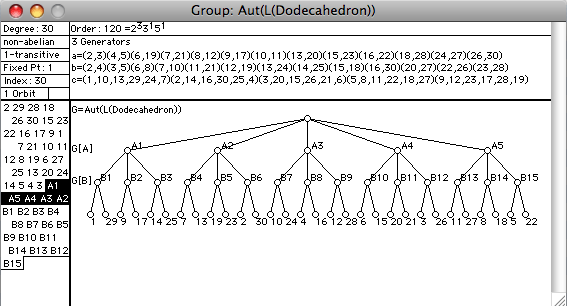Last update = 29 January, 2009



Group Functions Available in G&G 3.0
The Schreier-Sims algorithm is used to represent a permutation group as a tower of stabiliser subgroups. (Abstract groups are not supported). A group can be constructed by inputing its generators as permutations, or by constructing it as the automorphism group of a graph or digraph.List of Elements
A very handy feature is to be able to scroll through a list of the elements of a group. Scrolling through the automorphism group of a graph will often find a symmetry that leads to an interesting drawing of a graph, giving insight into its structure. One can also scroll through a coset of a subgroup.Block Systems
Click on an orbit to select it. Then find a block system for the group acting on that orbit. The result is displayed as a tree, as in the diagram above.Orbit Constituent
Click on an orbit to select it. Find the quotient group acting only on that orbit, and the kernel of its homomorphism.Subgroup of Prime Order
Given a prime p, G&G selects random perms in a group G until it finds one whose order is divisible by p. Then it constructs a subgroup of order p.Sylow Subgroup
Given a prime p and a group G, G&G starts by finding a subgroup K of order p. Then it selects random perms in G, looking for a perm g of order a power of p such that g that normalizes K. Then g is added to K as a generator. K is gradually built up in this way until it becomes a Sylow p-subgroup.Symmetrization
Given a group G acting on a set of n points in a graph window, one can add edges to the graph and symmetrize the graph to get the smallest graph containing these edges such that G acts as an automorphism group. For example, Cayley graphs and combinatorial designs with a prescribed group can be constructed in this way.Cayley Graphs, Scheier Coset Graphs
Given a subgroup K of a group G, G permutes the right cosets Ka, by right multiplication by the generators of G. G&G will find the graph and/or digraph whose vertices are the cosets of K, with edges determined by the generators of G. This is the Schreier Coset Graph (or Digraph). If K is the identity subgroup, the result is a Cayley graph of G.Double Cosets
Given a subgroup K of a group G, and a coset Kg, G&G will find the double coset KgK as a union of right cosets, KgK = Ka1 + Ka2 + ... + Kam. It will also construct a double coset graph whose vertices are the right cosets of K, in which coset Kg is adjacent to each of Ka1, Ka2, ..., Kam, and in which G acting by right multiplication is a group of symmetries.Show Isomoprhisms
If X and Y are two isomorphic graphs, G&G will make a list of all isomorphisms mapping X to Y. If X and Y have the same vertex set, these will be permutations. If they have overlapping or disjoint vertex sets, this will be a list of partial permutations.Group Products
Given two groups G and H, G&G will construct their wreath product, direct product, and a subdirect product.Normalizers, Centralizers
Given a subgroup H of G, G&G will construct the normalizer of H in G. Given a permutation g in G, it will construct the centralizer of g. It will also find the centre of G.Also...
Stabilizer Subgroups, Even Subgroups, Commutator Subgroups, Normal Closure, enumerating the Cosets of a Subgroup, Kernels of Quotient Groups, etc.
 Back to the Groups & Graphs home page.
Back to the Groups & Graphs home page.